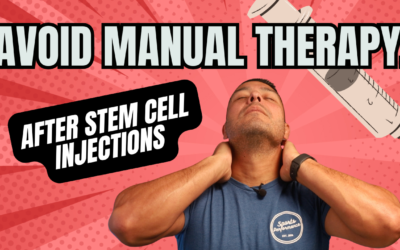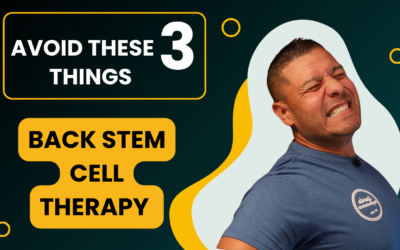“Surgery vs. Stem Cell Therapy: Which Recovery Path Is Right for You?”
When it comes to recovering from joint injuries, many people weigh the options between traditional surgery and stem cell therapy. Both approaches can lead to significant improvements, but how do they truly compare in terms of recovery time, ease, and outcomes? Dr. Chris Garcia, a stem cell recovery expert, breaks down the essential factors to consider when choosing between these options.
1. Understanding Recovery Timelines
One of the most common questions about stem cell therapy and surgery is how long each recovery takes. Many believe that stem cells offer a “quick fix,” but Dr. Garcia shares that, in practice, both options have nearly identical recovery timelines. With both treatments, a patient can expect to spend about 6-12 months before reaching a point where they feel fully recovered.
This similarity surprises many people who expect a faster recovery from stem cell therapy due to the lack of incisions. In reality, the tissues and structures still require the same healing and strengthening process, regardless of the treatment choice.
2. The Stem Cell Therapy Process
Stem cell therapy has a clear, structured recovery plan. Here’s a general timeline:
- Weeks 0-2: Minimal physical activity as the stem cells start to integrate.
- Weeks 2-6: Gentle movement with light exercises on a treatment table, gradually reintroducing the body to movement.
- Weeks 6-12: Progressively adding more resistance and weight-bearing exercises to build strength.
- Months 4-6: Increased loading and resistance to develop muscle tolerance and endurance.
- Months 5-6: Introduction to sports-specific drills and, finally, returning to competitive play around month six.
Dr. Garcia emphasizes that a strict protocol helps patients ease into activity safely, and those who follow this protocol often find great success.
3. The Surgical Recovery Path
For those considering surgery, the recovery timeline mirrors that of stem cell therapy, though with some variations. Here’s what to expect:
- Weeks 0-6: Restricted to gentle movement and basic physical therapy exercises.
- Weeks 6-12: Introduction of resistance and basic functional activities.
- Months 4-6: Transitioning into sport-specific exercises and more intensive physical therapy.
- Month 6: Resumption of sports, though many patients may still require additional time to regain full function.
Dr. Garcia notes that surgery patients often approach recovery more conservatively due to the physical incision, which serves as a reminder of the healing process taking place inside the joint.
4. Choosing Between Surgery and Stem Cell Therapy
If the recovery timelines are so similar, what factors should influence your decision? Dr. Garcia suggests that the choice between surgery and stem cell therapy should be based on your specific goals, lifestyle, and consultation with healthcare professionals.
Both methods offer comparable long-term outcomes, so the decision should come down to your recovery preferences and comfort. Those who prioritize avoiding surgery might lean towards stem cells, while others may prefer the surgical route if they feel it aligns better with their needs.
5. Key Advice for a Successful Recovery
Whichever path you choose, a successful recovery hinges on a few important points:
- Find a Qualified Professional: Not all providers are equally experienced in stem cell recovery. Seek out specialists who understand the unique demands of stem cell or surgical recovery.
- Follow the Plan: Resist the urge to rush your return to activity, even if you feel “fine.” Proper recovery takes time, and sticking to a structured plan will yield the best results.
- Be Realistic: Both surgery and stem cell therapy generally require 6-12 months before a patient feels back to normal. Keep this timeline in mind when setting your expectations.
Final Thoughts
Choosing between surgery and stem cell therapy can be a challenging decision. While the appeal of a quicker recovery with stem cells is understandable, it’s essential to recognize that both options demand similar timelines and commitment. Dr. Garcia’s experience with patients worldwide confirms that each approach requires careful adherence to a structured recovery process to ensure long-lasting health and functionality.
Need More Guidance?
For more resources or assistance with your recovery, feel free to contact the Stem Cell Recovery Experts who specialize in stem cell rehabilitation. For more recovery tips and long-lasting results, feel free to call us (619-397-1391). We’re here to help!
If you found these tips helpful, don’t forget to subscribe to our YouTube channel (CLICK HERE) for weekly updates on how to recover safely and effectively after stem cell therapy.
If you’re a visual learner, check out the YouTube video I created on this topic:
Sincerely,
Dr. Chris Garcia, PT, DPT, SCS, CSCS, USAW

“Dr. Chris Garcia is the world-renowned expert on stem cell recovery, internationally recognized public speaker, and trusted advisor to physical therapists globally.”
The 3 Most Important Things to Focus On After Stem Cell Injections
"The 3 Most Important Things to Focus On After Stem Cell Injections"Stem cell therapy is a game-changing treatment for those seeking relief from chronic pain and injuries. However, the key to maximizing its benefits lies in the recovery process. Dr. Chris Garcia, a...
Why You Should Avoid Manual Therapy After Stem Cell Injections
"Why You Should Avoid Manual Therapy After Stem Cell Injections"Recovering from stem cell injections is a meticulous process that requires patience and careful adherence to recommended protocols. A common question patients ask is whether manual therapy or massage can...
Low Back Stem Cell Recovery: Avoid These 3 Common Mistakes
"Low Back Stem Cell Recovery: Avoid These 3 Common Mistakes"Recovering from stem cell injections in your low back can be a transformative journey, but knowing what to avoid is just as important as knowing what to do. Many people unknowingly make mistakes that lead to...



